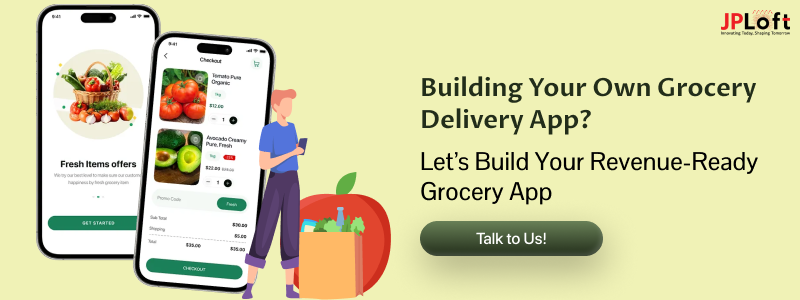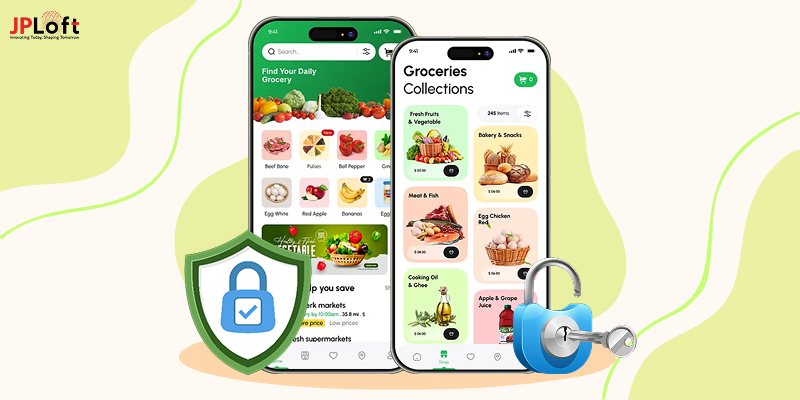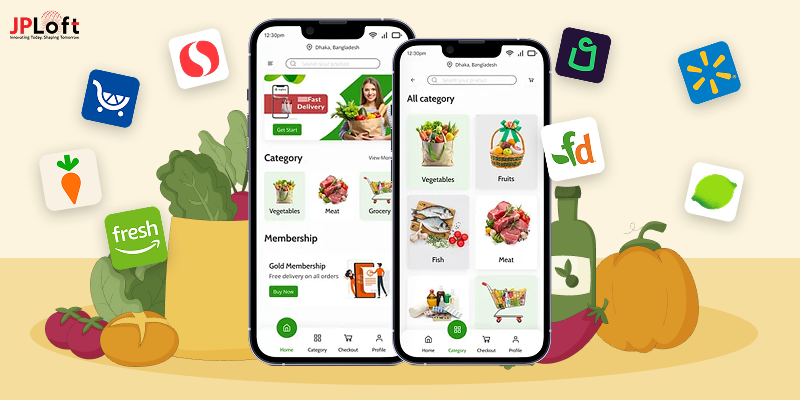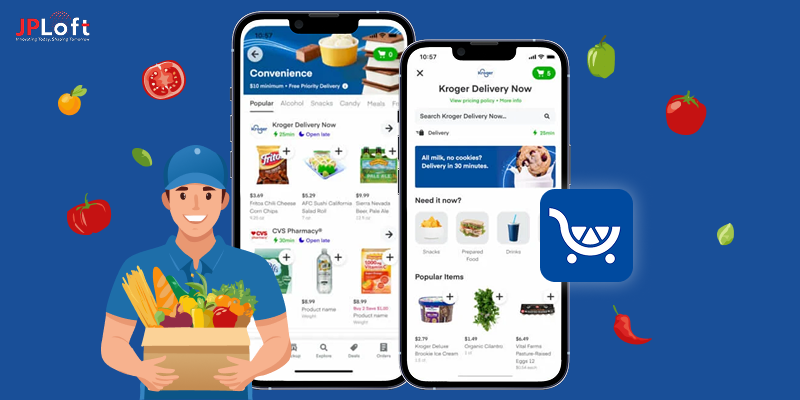Grocery delivery apps have changed the entire grocery shopping experience with their speed and convenience. The demand for doorstep grocery delivery services is high, and as the market growth continues, new startups and entrepreneurs are inclining towards this market and are interested in making money out of it.
These apps operate in a highly competitive yet promising market. On the surface level, users may see free downloads and frequent discounts on these grocery delivery apps, but underneath the surface lies a strategic monetization model that fuels their profitability scale.
Understanding the revenue generation process of these grocery apps is not just important for developers and investors but also for retail shops looking to digitalize their business presence.
In this blog, we will explore monetization strategies and other relevant information to help you start generating income from your grocery delivery app.
Key Takeaways
The grocery delivery industry is growing rapidly and is estimated to reach USD 5.67 billion by 2025 with a CAGR of 20%.
Monetization of the app supports feature upgrades, operational costs, customer retention, and long-term sustainability of the app and the business.
Top grocery delivery apps use hybrid monetization models such as delivery fees, commissions, data insights, subscriptions, and ads to maximize their revenue.
The selection process of a revenue model involves analyzing your business model, audience behavior, competition, scale, and operational capabilities.
Consult a professional grocery app development company, JPLoft, to turn your idea into a long-term income source.
Grocery Delivery App and Related Stats
A grocery delivery app allows consumers to browse, order, and receive groceries from the local stores and grocery partners at their homes. These delivery apps offer features such as real-time tracking, scheduled deliveries, seamless integrated payment services, and subscription plans.
The grocery delivery app market has experienced substantial growth over the past few years, particularly since the pandemic. The demand for convenience and time-saving is just another top reason for the rapidly growing success of this market.
-
- According to The Business Research Company, grocery delivery apps and platforms alone are projected to increase from USD 4.7 billion in 2024 to USD 5.67 billion in 2025, growing at a CAGR of 20.5%.
- The global online grocery delivery services market is expected to reach up to USD 1.18 trillion between 2025 and 2029, growing at a CAGR of 23.1%, according to the studies of Technavio.
- According to Research and Markets, it is estimated that the grocery delivery software market will reach USD 11.83 billion by 2029, growing at a CAGR of 20.2%
- In a survey held by Statista, performed in 53 countries among the audience aged 18 to 64, global consumer adoption of grocery delivery services has been in constant high demand due to pandemic-driven behavior shifts.
- According to the study by Capital One Shopping, 82% of US households ordered their groceries online in three months.
- 40% of customers order groceries online weekly, an average of 2 orders per week, as found in the study by DriveResearch.
With this stat, we understand that the explosive growth of the online grocery delivery service market is huge and highly monetized. This trend is going to continue growing as tech convenience advances and remains the priority for users globally.
Now let's go through key reasons why you have to monetize a grocery delivery app and how it will help your business grow in the future.
Why Monetize a Grocery Delivery App?
Monetizing the grocery app is essential for the growth of both the business and the app. It helps to upgrade the grocery delivery app features, find innovative ways to make the app more interactive, and improve customer satisfaction. Below are the top crucial reasons why grocery delivery app money-making strategies are important:
1. Generating Reliable Revenue Streams
The choice of the right monetization model according to the app type and its targeted audience can create various sources of revenue. Such as getting commissions on every order placed at the partnered grocery store, a dynamic or fixed delivery fee, and subscription or membership plans for the customers.
2. Maximizing App Value and Growth
Many brands and stores pay the grocery delivery apps for in-app advertising and sponsored listings to gain consumers' attention. Some grocery apps also generate earnings by upselling and cross-selling.
3. Attracting and Retaining Users
Loyalty programs and referral bonuses help keep customers engaged, increasing the frequency of order placement and attracting new customers. Subscription or membership plans provide them with special benefits such as priority and free deliveries or exclusive discounts, increasing user retention.
4. Supporting Operational Costs
Monetization of the grocery delivery app helps with the long-term viability by generating a steady revenue to cover the operational costs. These costs include logistics, development of the grocery delivery app, operating costs, customer support, and marketing.
5. Creating Opportunities for Partnership
Affiliate marketing and partnerships with brands, local farms, and health-focused businesses help with additional income by targeting the right audience for the products.
6. Unlock Investor Confidence
A clean and strategic monetization model of the grocery delivery app will attract strong potential investors. This helps in improving the chances of securing funding or partnership for the future growth of the app and the business.
7. Enable Data-Driven Services
Monetizing user data ethically will allow you to boost the functionality of your app by giving your users personalized deals, product placement of brands, and premium marketing slots for the sellers.
Monetization of your grocery delivery app will help you turn just a service into a sustainable, user-first, revenue-generating business. Hiring the best mobile app development company will help your app thrive in this competitive digital market and stand out longer than the competitors.
After understanding the need to monetize the app, let's explore the best monetization models for grocery delivery apps to maximize their potential.
Top Grocery Delivery App Monetization Strategies
Here we have listed the most used monetization models by the leading grocery delivery apps of 2025 for optimizing their revenue generation.
By using a single one or combining these monetization models, depending on your grocery delivery app business model, your app can also help you generate revenue.
Let's see how grocery delivery apps make money.
► Delivery Fees
In this model, companies charge the customers a pocket-friendly delivery fee for every order. These delivery fees can vary depending on factors such as delivery urgency, distance, order size, or demand.
Some apps reduce or waive these fees for larger orders or through subscription plans in order to encourage repeat use. By dynamically adjusting delivery fees, apps can maximize income while balancing demand and customer satisfaction.
Benefits:
-
Predictable recurring revenue per order.
-
Encourages customers to place large orders to reduce the cost of delivery for each item.
-
Maximizes profits during peak usage.
-
Encourages off-peak ordering, balancing operational load.
Revenue source: End users
Best for: All business sizes
Example: Most delivery apps
► Subscription/Membership Plans
This model offers users the option to pay for monthly/quarterly/yearly membership plans for using the premium features. Premium features include fast delivery, unlimited no-fee deliveries, exclusive members-only discounts, and priority customer support.
These plans are tailored to specific user requirements, encouraging long-term engagement with the platform. Many apps include loyalty rewards or cashback offers for subscribers, increasing perceived value. This locks in the users, creating a predictable and recurring revenue stream.
Benefits:
-
Recurring revenue stream.
-
Increased customer lifetime value (LTV).
-
Builds brand loyalty and reduces churn.
Revenue source: Premium users
Best for: Loyal, large customer base
Example: Instacart+, Amazon Fresh
► In-app Advertising
Many brands and stores pay for premium ad placement, banner ads, featured products, or sponsored listings of their products. As the app scales, advertising can become one of the main streams of generating revenue. Advertisers pay for premium placement to increase product visibility and drive sales directly through the platform.
This model not only provides additional revenue for the grocery delivery app but it also greatly benefits advertisers by reaching out to users at the exact moment of purchase intent, making it one of the most popular monetization models.
Benefits:
-
High-margin revenue.
-
Brands are willing to pay for visibility and placement.
-
Doesn’t affect end-user pricing.
Revenue source: Brands/FMCG companies
Best for: High-traffic apps
Example: Instacart+, Amazon Fresh
► Commission-Based Model
Apps can also charge a percentage commission from partner stores for every completed order processed through their platform. This is the main source of income for marketplaces and creates recurring revenue as the customers place orders.
Even a small commission percentage can bring in substantial revenue on a large scale as the order volume increases. By encouraging more vendors to join the platform, these incentives raise the platform's value proportion for users.
Benefits:
-
Scalable and asset-light.
-
Allows rapid market expansion via store partnerships.
Revenue source: Store/Vendor partners
Best for: Marketplace models
Example: Instacart, Shipt
► Private Labels
Apps launch and promote their grocery brand items, earning higher margins. Companies that own warehouses or inventory go with this strategy, as they do not have to pay another company for storing and stocking.
This integration not only boosts profit margins but also ensures better quality control and supply chain efficiency. Businesses that manage their inventory in-house are better able to react to changes in demand and reduce their reliance on outside vendors.
Benefits:
-
Better margins (10–30% compared to 1–3% in branded goods).
-
Brand exclusivity increases retention
-
Greater control over quality and pricing.
Revenue source: In-house product sales
Best for: Mature apps with warehouse capabilities
Example: Walmart, FreshDirect
► Premium Store Listings
This model gives stores and brands the option to pay extra to be featured prominently in search results or on the homepage of the grocery delivery platform. This increases the visibility of the product of that particular brand or store, boosting their sales.
This model also helps in generating advertisement revenue without affecting the user experience. Over time, these models foster strategic brand partnerships and targeted promotional campaigns, influencing user purchasing decisions.
Benefits:
-
Generates a steady, high-margin income stream beyond transaction fees or commissions.
-
Easily adaptable as the app expands, encouraging more vendors to participate and invest in premium features.
-
Apps can leverage analytics to recommend premium upgrades to stores likely to benefit most.
Revenue source: Store/Vendor partners
Best for: Marketplace models
Example: Instacart, Amazon
► Data Analytics Monetization
Grocery delivery apps largely depend on leveraging data analytics to generate revenue beyond traditional ways. Aggregated and anonymized shopper insights can be sold to companies and brands for internal analytics, enabling smarter advertising and upselling opportunities.
This data helps brands understand regional demand patterns, peak purchasing times, and consumer preferences at the ground level. These user behavioral insights can also guide apps for product placements, promotional timing, and inventory stocking strategies.
Benefits:
-
Non-invasive, high-margin revenue.
-
Helps brands optimize campaigns and product placement.
Revenue source: Insights for partners
Best for: Scaled platforms
Example: Large platforms like Amazon
► Cross-Promotions
Apps can partner with other food delivery, pharmacy, or adjacent companies to encourage customers to purchase more and generate commission from partner platforms. These collaborations also enable platforms to expand their product offerings without having to start from scratch with new verticals.
By partnering on apps, they share audiences through joint discounts and collaborative offers. This leverages each other's customer base to increase order counts. Gradually developing an ecosystem where users can satisfy various needs with a single app.
Benefits:
-
Indirect monetization via partnership commissions.
-
Enhances user acquisition and engagement.
Revenue source: Partnering business
Best for: All types of business
Example: Local delivery apps
► Bundling Offers Model
This model groups related or complementary products into a single discounted package, promoting customers to buy extra, increasing the overall order value. By providing better value for the money, this monetization strategy also increases customer satisfaction and cultivates a loyal user base for the app.
Bundling promotes faster checkout times and increased conversion rates by reducing decision fatigue. Moreover, it also helps in clearing out slow-moving inventory by pairing it with popular items.
Benefits:
-
Bundling multiple apps encourages users to spend more upfront.
-
Encourage users to explore and engage with various app components.
-
Can be offered as subscriptions, in-app purchases, or one-time offers, providing diversified income.
Revenue source: End users
Best for: Increasing order value
► Logistics Services
Some apps also outsource deliveries to third-party logistics companies and charge fees for this service. These platforms provide their fleet on rent for deliveries without giving any ownership to these third parties.
They manage scheduling, routing, and delivery tracking through their logistics systems. Without requiring significant infrastructure investments, apps can scale quickly by utilizing this hybrid delivery model.
Benefits:
-
Diverse revenue streams
-
Optimized operational costs
-
Partnership with merchants and third parties
Revenue source: External businesses
Best for: Apps with their delivery network and fleet
Example: DoorDash, Postmates
Anyone learning the right strategies of how to monetize a grocery delivery app can easily make their revenue out of the pool with long-term benefits. Start small, learn, hire dedicated developers, implement, experiment with different models available, and scale as your grocery delivery app grows.
Let's go through some case studies of how grocery delivery apps make money and have marked their position in this industry.
How Top Grocery Delivery Apps Make Money? Case Studies
The grocery delivery app market is booming, and so is the competition among apps. By integrating the right features and ideas, some of these apps have made it to the stage of the world’s leading grocery delivery apps. Let's explore what strategies and grocery delivery app revenue models they have used to reach the top.
1] DoorDash (Grocery Delivery Arm)
Business model: Marketplace + Logistics Model
Monetization Strategies:
-
Delivery and service fees
-
Subscription model (DashPass)
-
Retailer commissions
-
Sponsorships and ads
-
White label logistics (DoorDash Drive)
Key Takeaway: DoorDash takes advantage of existing infrastructure and brand loyalty to enter the grocery delivery market. They monetize their grocery arm through multiple approaches such as B2B logistics, advertising, and subscription. This helps them grow without owning any stock or warehouse.
2] Walmart Grocery
Business model: Inventory-led model
Monetization Strategies:
-
Delivery fees
-
Walmart+ subscriptions
-
Product margins (in-house products have high profit margins)
-
In-store pickup option (increases app engagement)
-
Ads & promotions
Key Takeaway: Walmart uses deliveries to extend its existing retail dominance while also using them as one of its monetization strategies, along with subscription plans and advertisements.
3] Amazon Fresh and Whole Foods
Business model: Inventory-led + third-party marketplace + logistics
Monetization Strategies:
-
Prime subscription bundling
-
Private labels
-
Cross-selling
-
Logistics Service
Key Takeaway: Amazon doesn't earn directly from its delivery services, so it uses Fresh as its user retention tool to increase the Prime memberships and promote cross-category purchases.
4] InstaCart
Business model: Marketplace model
Monetization Strategies:
-
Delivery fees
-
Service fees
-
Instacart+ subscriptions
-
Retail partnerships
-
Featured listings and ads
Key Takeaway: Instacart aims to earn from both its customers and the retailers. They implement diversified strategies such as commissions and advertising.
5] Shipt (by Target)
Business model: Membership-based marketplace
Monetization Strategies:
-
Membership fees
-
Delivery charges for non-members
-
Retailer partnerships
-
In-app tips and convenience fees
-
Cross-promotion with Target
Key Takeaway: Shipt's main revenue generation source is its subscription-first model. While they use Target’s ecosystem to give exclusivity and shopper loyalty.
6] FreshDirect
Business model: Inventory-led
Monetization Strategies:
-
Product margins
-
Delivery fees
-
DeliveryPass subscription
-
Corporate partnership
-
Private label brands
Key Takeaway: FreshDirect focuses on monetizing its product quality and exclusivity. They blend the high profit margins with a loyal urban customer base.
These case studies show how top online grocery delivery brands, over time, built layered grocery delivery app monetization methods to scale their growth. Whether you have just launched a grocery delivery app or have an established one already and are finding ways to improve it, borrowing insights from these case studies could help monetize grocery delivery app in 2025 and build your app to be resilient and profitable.
Now let's go through ways you can decide which monetization model will work best for your grocery delivery app in 2025
How to Select an Ideal Money-Making Model for a Grocery Delivery App?
Choosing the right monetization model for your grocery delivery app is one of the critical moves to be made with the right consideration factors that will affect your app. It is necessary to make this choice by analyzing your market, customer preferences, operational resources, and your competition in the market.
Here’s a step-by-step guide to help you decide which money-making models for a grocery delivery app will align best with your grocery delivery app:
Step 1. Understand the Common Revenue Models
If you browse around for the best revenue models for your app, you might find tens of them. But choosing the reliable model starts from hunting down which model leading successful apps follow. The majority of the grocery delivery apps generally leverage one or more of these listed grocery delivery app monetization models in 2025, such as delivery fees, commission-based models, etc.
Step 2. Identify Your Business Model
Next, we need to understand what your grocery delivery business model type is to choose the correct monetization model. Identify your app functionalities, as each model has different and unique grocery delivery app monetization strategies, needs, and opportunities. It can be a marketplace model (connects customers to multiple grocery stores), an inventory-led model (owns or manages the grocery stock), or a hyperlocal model (connects local stores for fast delivery within short distances).
Step 3. Know Your Target Audience
Your targeted customer will shape your revenue model. A deep understanding of the financial choices of your customer will help you align monetization with expectations. Go through surveys that clear these doubts about your customer for you, such as whether your customers are price-sensitive, prefer convenience or low cost, and will your customer pay for premium services?
Step 4. Operational Capability and Costs
Evaluate your logistics, workforce, and fulfillment strengths to better understand what and how much is necessary. If you don't handle product inventory, commission, and delivery fee models, they will do the work. But if you handle the warehouse (inventory), go for models with higher margins to cover the expenses.
Step 5. Analyze Your Competition
Don't let others' failures go to waste, and learn from those already thriving in the online grocery delivery industry. Study the type of revenue models they used and what grocery app development challenges they faced, what changed, and how they finally chose the one that helped them make it to the top of the industry.
Step 6. Balance Free and Paid Features
Decide smartly how to balance free and paid features in your grocery delivery app. A freemium version can work wonders if used strategically. Offer core services for free and retain users, and provide premium services through the delivery app after payment. This often encourages the user to upgrade their membership to premium over time.
Step 7. Mix and Match for Optimization
Many successful grocery delivery apps usually combine two or more revenue models to diversify income and improve adaptability. A few examples:
-
For marketplace and aggregator-type: Commission + Delivery Fee
-
For occasional and regular deliveries: Delivery Fee + Subscription
-
For large-scale customers and multiple warehouse businesses: Advertising + Ancillary Services
Step 8. Test and Iterate
It's not necessary to make the perfect first move, but to make a move with what you have. Begin with the most common hybrid strategies used by your type of grocery-delivering apps. Such as combining delivery fees with membership plans and then monitoring the performance closely. Track key metrics like customer acquisition cost (CAC), average order value, retention rates, and conversion rate of paid plans.
Selecting the right mobile app monetization model is not just a one-time decision; you have to test and find the most suitable one for your grocery delivery app. This decision will be highly balanced between the user satisfaction level and business profitability.
Build Your Grocery Delivery App with JPLoft!
In this fast-evolving online grocery delivery industry, having a cutting-edge app is crucial to engaging customers’ attention and retaining it. JPLoft, a premier grocery delivery app development company, offers customized, scalable, and feature-rich solutions that smoothly align with your business requirements.
Whether you are a grocery startup or an established grocery chain, our professional developers know exactly how to transform your vision into a digitally monetizable delivery app. We prioritize delivering apps equipped with essential features such as easy user registration, smart product search, secure payment gateways, real-time order tracking, and personalized recommendations to give your users the best grocery ordering experience.
Empower your grocery delivery service with a high-end app designed and developed by the specialized professionals of JPLoft, and get your business a digital revenue stream.
Conclusion
Grocery delivery apps generate revenue through a combination of various proven monetization strategies, such as delivery fees, store commissions, subscription plans, and in-app advertising. They balance these monetization strategies with customer satisfaction and profitability.
Monetizing a grocery delivery app is crucial as it covers the logistics and operational costs of the company. It also improves the sustainability of the app by covering operating costs and frequent quality upgrades.
Most successful grocery delivery apps integrate a few key features to reach the top, such as hybrid monetization, data-backed personalization, speed, and, of course, convenience. With the right balance of value and profitability, your grocery delivery app will not just serve the purpose but thrive in this market.
FAQs
Most grocery delivery apps charge customers delivery fees, convenience fees, and service charges to generate their revenue. A few apps also offer subscription plans and memberships, which consist of premium features such as free deliveries, discounts, and priority support.
Yes, grocery delivery apps earn a commission of around 10-20% on each order placed from the partnered stores and vendors. In return, these partnered stores and vendors get access to a larger customer base and logistical support.
Yes, many grocery delivery apps practice cross-selling related products and services like pet foods, household items, or meal kits. Some apps also provide logistics-as-a-service, letting other businesses/vendors use their delivery fleet for a fee without any ownership of the fleet.
Subscription plan models generate constant recurring income for the grocery delivery platform. It also helps in increasing customer loyalty for the brand. All while users get the benefits of free priority delivery and exclusive offers.
Yes, grocery delivery apps can earn through ads and promotions of other brands. As brands pay a ransom for getting featured listings, banners, or sponsored products through the delivery app. These strategies are used by high-traffic apps such as Amazon Fresh.












Share this blog